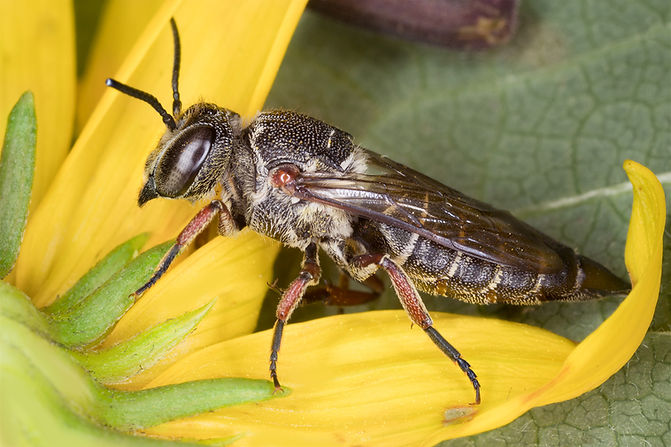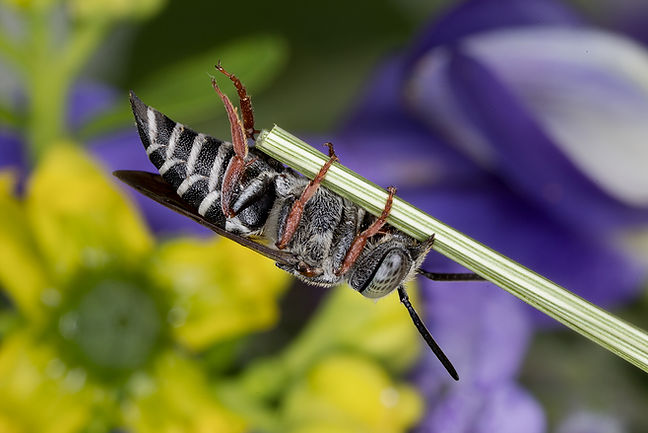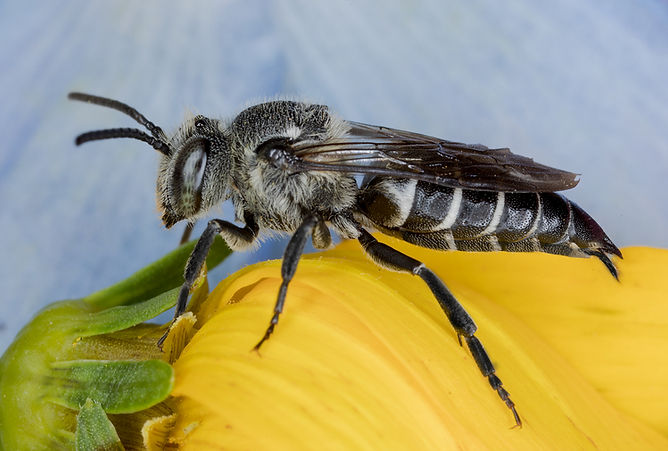SHARP-EATMAN
NATURE
PHOTOGRAPHY
ID GUIDE TO WILD BEES - NEW YORK

CUCKOO LEAFCUTTER BEES
Genus Coelioxys

Cuckoo leafcutters invade leafcutter bee nests and deposit eggs in them. When the cuckoo's young hatch, they eat the hosts' eggs or slaughter its young, and then devour the stores of nectar and pollen left by the mother leafcutter for her offspring. The cuckoo larvae then mature within the nest, and later emerge as adults. When such attacks occur late in the season, cuckoo larvae may spin cocoon-like structures inside of their hosts' nests and overwinter in them.
Many cuckoo bees of other types -- for example, Triepeolus cuckoos (which usually prey on long-horned bees) and nomad bees (which usually prey on Andrena mining bees) -- are not closely related to the bees they parasitize. Such cuckoos are shown on the cuckoo bee page of our guide. We have chosen to feature leafcutter cuckoos immediately after the leafcutter section of this guide, however, because both belong to the same bee tribe and somewhat resemble each other. Within that tribe, leafcutter cuckoos comprise a genus called Coelioxys; leafcutters belong to the genus Megachile.
The Greek Coelioxys means "sharp belly," a genus name that refers to the tapered, pointed abdomens of cuckoo leafcutters. As shown at right, female Coelioxys have spade-shaped abdominal tips that allow the cuckoos to break through the brood-cell walls that leafcutters construct with leaves, petals and other materials. Male cuckoo leafcutters have abodomens armed with multi-pronged tips.
According to entomologist Charles D. Michener, members of the genus Coelioxys share the distinctive trait of having hairs on their eyes. In addition, the wings of the cuckoo leafcutter bee have only two submarginal cells, and the back rim of the bee's scutellum (the second segment of the thorax) has prominent toothlike protrusions called axilla (These traits are shown here in the photo strip.)
Genus Coelioxys - Cuckoo Leafcutters
1/4" - 1/2" (small to medium-sized)


Above left : A male Say's cuckoo leafcutter bee resting upside-down
Above right: The pointed abdominal tip of a female cuckoo leafcutter
Below right: The multi-pronged abdominal tip of a male cuckoo leafcutter
Below: A modest cuckoo leafcutter gripping a stem with its jaws

Female cuckoo leafcutters are easily recognized by their long, cylindrical, pointed abdomens.

The tip of a female cuckoo leafcutter abdomen: female cuckoo leafcutters have abdomens that taper to a point. They also have stingers.

Male cuckoo leafcutters have multi-pronged abdominal tips and lack stingers.

Hairy eyes are a distinguishing trait of the genus Coelioxys. In our area, both male and female cuckoo leafcutters usually have green eyes.

Cuckoo leafcutters tend to have heavily pitted thoraxes. The rear edge of the Coelioxys scutellum (2nd thorax segment) has two pointed protrusions called axillae. Specific features of the scutellum and axillae aid in species identification.

Cuckoo leafcutters are differentiated in part by their leg color. This bee, an immaculate cuckoo leafcutter, has legs that are black on the top segments and red on the bottom segments.
A female Porter's cuckoo leafcutter

A female Porter's cuckoo leafcutter bee: note that the bee's legs are black.

Like other Northern cuckoo leafcutters, the female Coelioxys porterae has a pitted head and thorax. On either side of the hind edge of the scutellum (the back portion of the thorax) are two tooth-like projections.

The sixth segment of the female Porter cuckoo leafcutter's abdomen is elongated. This trait makes female bees of these species appear especially long-bodied when viewed with the naked eye.

The tip of the abdomen of a female Porter's cuckoo leafcutter: note that the tip has a tooth-like notch on each side, near the point.
CUCKOO LEAFCUTTERS
of the Subgenus Cyrtocoelioxys
Modest Cuckoo Leafcutter
Coelioxys modestus
1/4" - more than 1/2" (small to medium-sized)
A female immaculate cuckoo leafcutter


A large female modest cuckoo leafcutter. This bee's legs are black on the top segments (the femur and tibia) and red on the lower segments. This bee measured nearly 3/5" long.

The thorax of the large female modest cuckoo leafcutter. The bee's thorax and head are heavily pitted, and the scutellum (near the rear of the thorax) sports two long teeth (axillae) on its bottom ridge.

The abdomen of the large female cuckoo leafcutter. Note that the front edge of the first segment is ridged with pale hairs. Longish, sparse hairs grow from the bee's "shoulders".

An alternate view of the short hair rimming the ridged front of the first segment of the bee's abdomen. On either side of the hair-lined ridge are sparse, longer hairs on the bee's "shoulders".
Synocoelioxys leafcutter. The male cuckoo leafcutter shown here belongs to the subgenus Synocoelioxys. Synocoelioxys cuckoos prey specifically on leafcutters of the subgenus Sayapis -- such as the frugal, pugnacious and hostile leafcutters featured near the top of this page.
Cuckoos of this subgenus are common visitors of aster-family flowers, such as sunflowers, cornflowers, and black-eyed Susans. The bee shown here is feeding on rudbeckia.
Identification information: Coelioxys (Synocoelioxys) have black heads and thoraxes, and black abdomens encircled by white bands. Their legs are reddish-brown and their eyes dark olive-green. A distinguishing trait of this subgenus is that the white bands on the bees' abdomens are interrupted in the middle.
At least three species of the subgenus Synocoelioxys have been documented in New York State: Coelioxys alternatus, C. hunteri and C. texanus.
TAXONOMY - SYNOCOELIOXYS CUCKOO LEAFCUTTER
Family: Megachilidae
Subfamily: Megachilinae
Tribe: Megachilini
Genus: Coelioxys
Subgenus: Synocoelioxys
Right: A male
cuckoo leafcutter
of the subgenus
Synocoelioxys

This male of the subgenus Synocoelioxys is lifting its abdomen in a manner typical of cuckoo leafcutters. Like northern cuckoo leafcutter males, this male bee hasmultiple prongs on the tip of its abdomen.

Note the broken white bands on the cuckoo leafcutter's abdomen. This is a distinguishing trait of leafcutter cuckoos of this subgenus.



A female Say's leafcutter resting while gripping a mountain mint leaf with her jaws: note that the lower segments of the bees' legs are red. The top segments are black.

Close-up of the tip of a female Say's cuckoo leafcutter's abdomen: females use these their abdomens to dig into leafcutter nests.

A female Say's cuckoo leafcutter found hanging upsidedown, gripping a stem with its manidbles: note how heavily pitted the bee's thorax is. The scutellum (second segment) of the thorax has two two prominent axillae (toothlike protrusions) on either side.

The head of a female Say's leafcutter is covered with white hairs. The bee's clypeus (the part above the mandibles) dips upward in a shallow inverted-U shape.
Northern Cuckoo Leafcutters
of the subgenus Boreocoelioxys
Porter's Cuckoo Leafcutter
Coelioxys porterae
1/3" - 1/2" (medium-sized)
Say's Cuckoo Leafcutter
Coelioxys sayi
1/3" - 1/2" (medium-sized)
Eight-Toothed Cuckoo Leafcutter
Coelioxys octodentatus
3/10" - 1/2" (small to medium-sized)

A female Say's leafcutter gripping a mountain mint leaf with its mandibles


A male eight-toothed cuckoo leafcutter raising its abdomen tip in the air
Immaculate cuckoo leafcutters (Coelioxys immaculata) belong to the redundantly-named subgenus Coelioxys. These cuckoo leafcutters parasitize the nests of Megachile addenda leafcutters (shown higher up on this page).
During late spring of 2017, a large Megachile addenda aggregation appeared in the Rockwood Hall section of the park. Immaculate cuckoo leafcutters appeared in large numbers on the fringes of the aggregation. The cuckoos would park themselves two or three feet from a given hole and engage in the following behavior.
The cuckoos would wait, deathly still, blending into the dirt-and-crushed-pebble background of the nest area, watching the behavior of the female leafcutters. The female leafcutters would arrive at the nests periodically, bearing leaves to construct egg chambers one-by-one and depositing eggs in each successively. Each time a targeted female leafcutter finished a chamber and emerged to fly off and gather more leaves and pollen, the immaculate cuckoo leafcutter watching the nest hole would sneak into it like a burglar, presumably to pierce the outer wall of the newly-constructed egg chamber and to lay her own egg there. The cuckoo would then scamper from the hole a minute later and park again a few feet from the nest, awaiting the return of the female leafcutter bee. This process would repeat itself throughout the day, assuring that the cuckoo bee deposited eggs in each of the individual nest chambers after the leafcutter had painstakingly provisioned them for her own offspring.
Immaculate cuckoo leafcutters forage on such plants as blackberries, raspberries, milkweed and false indigo. The bees shown here were found feeding on cow vetch and clover.
Identification information: Immaculate cuckoo leafcutters have black heads and thoraxes; black abdomens banded with white hairs; and red legs with dark uppe segments. Females' faces are covered with short white hairs and bordered on the bottom edge of the clypeus (lower face) with a row of pale orange hairs. Females' eyes are green. A distinguishing trait of females of this species is the singular tip of the bee's abdomen -- shown in the photo here..
TAXONOMY - IMMACULATE LEAFCUTTER
Family: Megachilidae
Subfamily: Megachilinae
Tribe: Megachilini
Genus: Coelioxys
Subgenus: Xerocoelioxys
Species: Coelioxys immaculata
A female immaculate cuckoo leafcutter


A female immaculate cuckoo leafcutter bee

The upper segments of this female bee's legs are black, and the lower segments are red.

Dorsal view of a female bee: the bee's head and thorax are heavily pitted.

This female bee is covered with sand and pebbles because it has just dug into a leafcutter hole.
An immaculate cuckoo leafcutter backing out of the hole of a Megachile addenda leafcutter


Half an hour after transporting leaves to her nest, a Megachile addenda leafcutter backs out of her nest hole.

An immaculate cuckoo leafcutter lurking on the edge of a Megachile addenda nest area: the cuckoo, well camouflaged against the ground, spent the afternoon sneaking in and out of a leafcutter hole.

The immaculate cuckoo leafcutter scrambling into the the hole

The immaculate cuckoo leafcutter backing out of the hole a few minutes later
CUCKOO LEAFCUTTERS
of the Subgenus Synocoelioxys
Modest cuckoo leafcutters (Coelioxys modestus) belong to the subgenus Cyrtocoelioxys. They are cleptoparasites of the belted leafcutter (Megachile centuncularis) and of the resin bee species Megachile campanulae wilmingtoni (a variation of the bellflower resin bee, found in coastal areas of the southeastern United States). Although neither of these host bees has been documented in the preserve, it is likely that some belted leafcutters reside there, as this species is relatively common in the general New York area.
The two bees shown here illustrate the considerable size range of these bees. The smaller one barely measured 1/3", while the larger one was nearly 3/5".
The small modest cuckoo leafcutter at right was found foraging on goldenrod during early September 2017. The second, larger cuckoo (shown in the photo strip at right )was found outside the preserve -- in a public garden located in Riverdale, New York, 25 miles to the south of the preserve. This bee was feeding on sneezewort in early August, 2017.
Modest cuckoo leafcutters have been documented feeding on such plants as sunflowers, asters, ceanothus, sweet clover, sumac, verbena, bellflowers and mountain mint.
Identification information: Modest cuckoo leafcutters have dark red legs or red-and-black legs; black heads and thoraxes; and black abdomens banded by pale hairs. The last segment of the female bee's abdomen is distinctive, as shown in the photo strip at right. Female and male bees have dark brownish-green eyes.
As noted, modest cuckoo leafcutters range greatly in size -- from just over 1/4 " to more than 1/2" inch long. Few leafcutters in our area run so small, and thus the bees' modest size aids in their identification. The reverse is also true -- few cuckoo leafcutters in our area reach the 3/5" length of the second female bee shown here in the photo strip.
Three minute traits help identify females of this species: (1) when viewed from the side, the upper half of the sixth segment (T-6) of the female bee's abdomen is upturned; (2) the lower half of the last segment (S-6) of the female bee's abdomen sports a fringe of hair; and (3) the first segment of the female bee's abdomen is edged with pale hairs along its front ridge. Male modest cuckoo leafcutters have multi-pronged abdominal tips.
TAXONOMY - MODEST LEAFCUTTER
Family: Megachilidae
Subfamily: Megachilinae
Tribe: Megachilini
Genus: Coelioxys
Subgenus: Cyrtocoelioxys
Species: Coelioxys modestus
CUCKOO LEAFCUTTERS
of the Subgenus Coelioxys
Immaculate Leafcutter
Coelioxys immaculatus
1/3" - 1/2" (medium-sized)
Coelioxys of the subgenus Boreocoelioxys are known as northern cuckoo leafcutter bees. The vast number of cuckoo leafcutters found in Rockefeller State Park Preserve belong to this subgenus. The park's northern cuckoo leafcutters are represented by at least three species: Porter's cuckoo leafcutter; Say's cuckoo leafcutter; and the eight-toothed cuckoo leafcutter.
Porter's cuckoo leafcutters. According to entomologist J.R. Baker's voluminous 1975 treatise, Taxonomy of Five Nearctic Subgenera of Coelioxys, Porter's cuckoo leafcutters invade the nests of relative leafcutters Megachile relativa) and frigid leafcutters (Megachile frigida). Both of these leafcutter species are shown above.
Porter's cuckoo leafcutters feed on such plants as geraniums, false indigo, hydrangea, cranberries, blueberries, goldenrod and asters. The Porter's cuckoo leafcutters featured here were found drinking nectar from coreopsis and butterfly weed in the park's Visitor Center garden in late June and early July of 2017. These bees are relatively uncommon in the park.
Say's cuckoo leafcutters are the most common Coelioxys cuckoo bees found in the park. These cuckoos target the nests of flat-tailed leafcutter bees (Megachile mendica) (shown above). Sometimes, after the cuckoo's eggs have been deposited in flat-tailed leafcutter brood cells, the newly hatched cuckoos coexist with their prey, sharing the provisions left by the mother flat-tailed leafcutter. Field studies have documented Say's cuckoo leafcutters and flat-tailed leafcutters emerging from the same nest.
Say's cuckoo leafcutters drink nectar from a very wide array of flowering plants, among them, blackberries, melons, squash and sunflowers. The Say's cuckoo leafcutters shown here were found feeding in the park in July and August on orange butterfly weed, mountain mint and goldenrod.
Eight-toothed cuckoo leafcutters, like Says' cuckoo leafcuttters, infiltrate the nests of flat-tailed leafcutter bees. Eight-toothed cuckoo leafcutters also have been documented parasitizing the nests of at least four other leafcutter species: the common little leafcutter (Megachile brevis), the Texas leafcutter (Megachile texana), the alfalfa leafcutter (Megachile rotundata) and the belted leafcutter (Megachile centucularis). (The first three of these are shown above.)
Eight-toothed leafcutters forage on a broad range of wildflowers and native plants, among them elderberry, sumac, wild asters, onions and Virginia creeper. The male bee shown here was feeding on goldenrod on a sunny park trail in early September.
Identification information: All three of these northern cuckoo leafcutter species have dark abdomens banded by short pale hairs; thoraxes with prominent axillae; red, black or red-and-black legs; and green eyes. Females of these species have pointed, conical abdomens with spearlike tips. Males have impressive abdominal tips terminating in multiple prongs. Male Boreocoelioxys found in our area lack foveae (depressions) on the sides of their third abdominal segments.
Porter's cuckoo leafcutters are striking, long-bodied bees. They have all-black legs, a trait that makes them readily distinguishable from Say's and eight-toothed leafcutters. Other traits of Porter's leafcutters, visible only on minute inspection, include the following: (1) females have distinctive abdominal tips with tooth-like notches near the ends; (2) and they sport relatively long hairs on their eyes. (3) The abdomen of the male C. porterae also has prominent depressions on the first segment (T-1); and an unpitted line dividing the fourth and fifth segments (T-4 and T-5) (These traits are shown here in the first photo strip.)
Say's and eight-toothed cuckoo leafcutters have predominantly red legs and dark wings. The bees' tegulae (located where the wing joins the bee's body) are red. Both Say's and eight-toothed cuckoo leafcutter males have deep grooves that traverse the second and third segments of their abdomens (T-2 and T-3). On Say's leafcutters, these grooves may be interrupted in the middle.
These two species differ subtly (as shown hdfd in the second photo strip): (1) The female Say's cuckoo leafcutter has a distinctive clypeus (the face part above the jaws) with a shallow U-shaped lower rim. On female eight-toothed leafcutters, the lower rim of the clypeus runs straight across. (2) Male and female Say's leafcutters have legs that are black near the base and reddish on the lower segments. Eight-toothed leafcutters, by contrast, usually have entirely red (or mostly red) legs.
TAXONOMY - PORTER'S LEAFCUTTER, SAY'S CUCKOO LEAFCUTTER, EIGHT-TOOTHED LEAFCUTTER
Family: Megachilidae
Subfamily: Megachilinae
Tribe: Megachilini
Genus: Coelioxys
Subgenus: Boreocoelioxys
Species: Coelioxys sayi, Coelioxys octodentata
and Coelioxys octodentatus

This is a male eight-toothed cuckoo leafcutter, showing a many-pronged abdomen tip. Many cuckoo leafcutters share the habit of posing with their abdomens lifted into the air behind them.

This is a male eight-toothed leafcutter. The legs of the eight-toothed leafcutter are predominantly red. Note that the bee's tegula (the plate where the wing joins the bee's body) is also red.

This is the abdomen of an Eight-toothed cuckoo leafcutter -- note that the the grooves on the second and third segments cross the full width of the abdomen.

This is a a male eight-toothed leafcutter balancing upside-down by gripping a leaf with its mandibles.
This website's photos and text are protected by registered copyright. All photos are © 2014-2017 Paula Sharp & Ross Eatman, all rights reserved. To inquire about possible use of photos, see Permissions.
REFERENCES: For a comprehensive list of references used in compiling this guide, click here:
